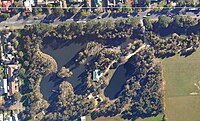
Photo from wikipedia
Plastic intake by marine vertebrates has been widely reported, but information about its presence in continental waterfowl is scarce. Here we analyzed faeces of waterbirds species (European coot, Fulica atra,… Click to show full abstract
Plastic intake by marine vertebrates has been widely reported, but information about its presence in continental waterfowl is scarce. Here we analyzed faeces of waterbirds species (European coot, Fulica atra, mallard, Anas platyrhynchos and shelduck, Tadorna tadorna) for plastic debris in five wetlands in Central Spain. We collected 89 faeces of shelduck distributed in four lakes, 43.8% of them presented plastic remnants. Sixty percent of 10 faeces of European coot and 45% of 40 faeces of mallard contained plastic debris. Plastic debris found was of two types, threads and fragments, and were identified as remnants of plastic objects used in agricultural fields surrounding the lakes. Differences in prevalence of plastic in faeces, number of plastic pieces per excrement and size of the plastic pieces were not statistically significant between waterfowl species. Thus, our results suggest that plastic may also be frequently ingested by waterfowl in continental waters, at least in our study area. Future studies should address this potential problem for waterbird conservation in other wetlands to evaluate the real impact of this pollutant on waterbirds living in inland water.
Journal Title: Environmental pollution
Year Published: 2017
Link to full text (if available)
Share on Social Media: Sign Up to like & get
recommendations!